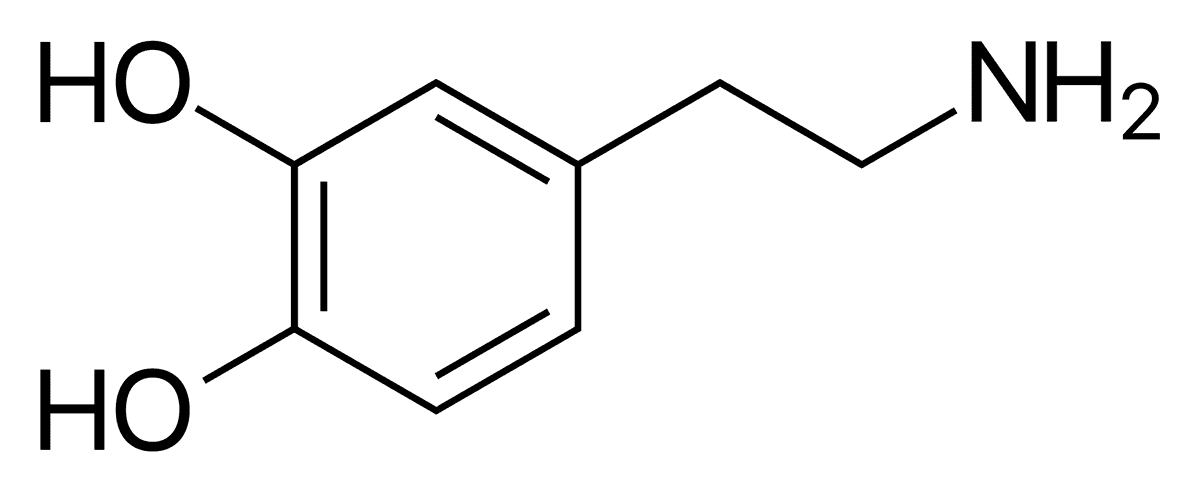Modified: December 21, 2022
dopamine
This page is from my personal notes, and has not been specifically reviewed for public consumption. It might be incomplete, wrong, outdated, or stupid. Caveat lector.Chemically, dopamine is a benzene ring (aka phenyl group), with two hydroxyl (OH) groups at adjacent sites, and a two-carbon (ethyl) chain hanging off the other side capped by an amine (NH2) group:

It is very similar to norepinephrine, which just has an extra hydroxyl group hanging off of the carbon chain, and epinephrine, which also has an extra methyl (CH3) group as a sibling of the amine group. Both are catecholamines: the benzene ring with two adjacent hydroxyl groups is the 'catechol', attached to an amine side chain. They are also substituted phenethylamines.
Dopamine is derived in the brain from L-DOPA, which has an extra COOH hanging off of the carbon chain as a sibling of the amine group. This is in turn derived from (L-)tyrosine, which is like L-DOPA but with only one hydroxyl group attached to the benzene ring. Here the amine group and the COOH act as the standard amino acid links, and the benzene ring + (single) hydroxyl is the side chain.
- Dopamine is not in itself a source of pleasure. We think it signals 'motivational prominence', i.e., that a recent experience should guide our future motivations, either positively (towards good things) or negatively (avoiding something bad).
- Dopamine is necessary for reinforcement learning. If you try to condition an animal, but inhibit their dopamine system during the training, then the positive association won't be 'stamped-in', and the conditioning doesn't work. Interestingly, if you only sometimes inhibit the dopamine system, it acts as a form of intermittent reinforcement, and the learned stimulus-response is actually stronger.
- This is an after-the-fact effect. A trained animal with dopamine disabled will continue to perform the behaviors they've been conditioned to perform. It's only after a long period of this that the conditioning fades as there is no new reinforcement of the behavior.
- One might hypothesize that this is due to anhedonia; that the rewards are not actually pleasurable once you take away the dopamine. There doesn't seem to be conclusive evidence for this. The alternative is that reinforcement can itself be a subconscious event, independent of subjective pleasure.
- Dopamine is strongly tied to the motor system.
- 'Dopaminergic neurons' release dopamine in the brain. Parkinson's disease is associated with the death of dopaminergic neurons. L-DOPA is a treatment.
There are five known types of dopamine receptors, but D1 and D2 are by far the most common (D3 and D4 are 'D2-like', while D5 is 'D1-like'). All are G protein-coupled receptors, which themselves are proteins that pass through the cell membrane seven times, and act inside the cell via the connected G protein. Such receptors are slower to act than 'direct' receptors in which the ligand binding directly gates a channel. The D1 receptor is linked to a 'stimulatory' G protein, while D2 is linked to a' inhibitory' protein.
- How do these actually affect neuron signaling?
Dopamine also does stuff elsewhere in the body, but it does not cross the blood-brain barrier, so this is mostly unrelated to its role as a neurotransmitter.
Sources: